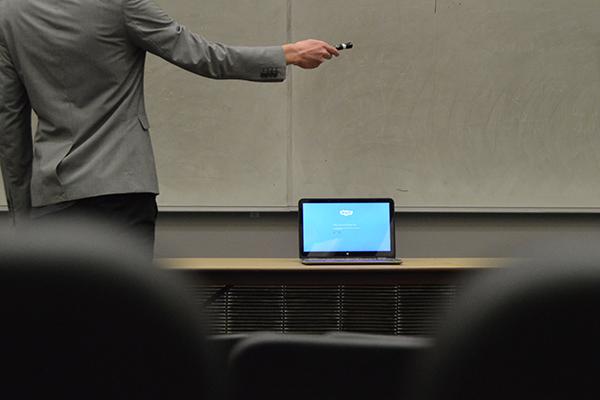Students on one of GW’s satellite campuses will soon be able to take courses with professors teaching from Foggy Bottom.
The University has installed video equipment at GW’s campus in Hampton Roads, Va. to allow students there to tap into classes on the Foggy Bottom Campus. As early as next fall, Hampton Roads students will be able to interact with classes on the Foggy Bottom Campus in real time, Vice Provost for Online Learning and Academic Innovation Paul Schiff Berman said.
Berman said the technology will give professors the opportunity to teach classes that reach the students who might be based on other campuses and aren’t able to travel to Foggy Bottom. The Hampton Roads campus generally holds classes in the Graduate School of Education and Human Development.
“So you would have students in both places,” he said. “The faculty member could speak to students in either location and can see, hear and speak to each other. It is one real-time class with students in two locations.”
Many Foggy Bottom classrooms currently use analog video equipment in class, an antiquated system as opposed to digital equipment, Berman said. As officials switch out the analog equipment for digital cables on campus, classrooms will also be outfitted with the technology to support classes held in two locations.
He added that there’s still room to expand the program to other courses and campuses. GW has two other graduate education campuses in Virginia, as well as the Virginia Science and Technology Campus and the Mount Vernon Campus.
Because the classes are already being held on Foggy Bottom, the process of connecting a remote classroom of students is less expensive than running a completely separate course or having a professor travel back and forth between two campuses, Berman said.
“It probably won’t be every class on the campus ever but there will be a substantial amount of classrooms that would have this capability if the need arises,” he said.
Georgetown University, one of GW’s peer institutions, holds a class where some students on campus take their class with an in-person professor while other students log in to the live class from their private computers, The Washington Post reported last month.
PB Garrett, an associate provost and the chief academic technology officer at GW, said in an email the classrooms in the three Foggy Bottom buildings were outfitted over the summer with brighter projectors, cameras that can pan, tilt and zoom to show all parts of the classroom and microphones that hang from the ceiling. Classrooms on the Virginia Science and Technology Campus were also included in the upgrades.
Some classrooms in the Elliott School of International Affairs building, Duquès Hall and the Media and Public Affairs building were renovated over the summer to be able to support the format. Students in classrooms on both the Foggy Bottom and Hampton Roads campuses will be taught by the same Foggy Bottom professor.
Garrett added that more buildings will see these digital upgrades as their digital upgrade plan continues this summer and next summer. On the Hampton Roads campus, classrooms got large LCD displays, a sound-bar with integrated camera and table microphones.
Students will be able to check in on their classes using their laptops and any sort of web conferencing application, like Skype or Google Hangouts, she said. In the past, the only way to connect classrooms across campuses would have been to use specific teleconferencing hardware, which can be expensive.
“While this, in some ways, is still considered the highest quality, it is not without its drawbacks,” Garrett said. “Also, to connect more than two sites together also requires additional licensing or server hardware which adds to the cost.”
Garrett added that it’s the University’s commitment to technology that means students are able to take classes remotely while still taking a class in real-time.
“GW leadership has made an important investment to upgrade our general-purpose classrooms from analog to digital which will allow for robust web-conference based collaborative tools for our students enrolled in face-to-face type courses at remote sites as well as our students enrolled in online courses,” Garrett said.







